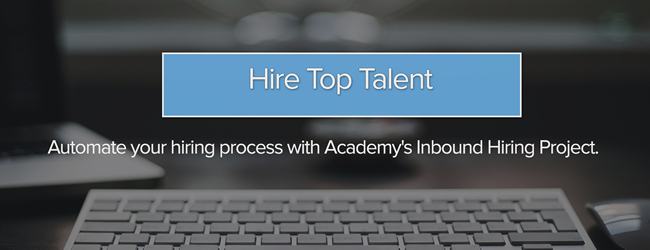As you grow your company’s team, it’s important to spend time developing a hiring process, sourcing candidates, and honing your interview skills. But how can you ensure you spend your time interviewing the best possible candidates?
Before you even meet a candidate face-to-face, a well-crafted job application will help you get a better sense of the competencies of your candidates, as well as protect your business from costly hiring mistakes.
Follow these five tips to optimize your job application form so that you can more effectively evaluate your candidates, while also improving the candidate experience.

Tip #1: Avoid long forms by determining the most important things that you need to know.
Start by reviewing the conversion rate for your job application pages. If you find that candidates are viewing your job application page, but the majority are not filling out your form, take a hard look at the questions you ask. Are you asking questions that are repetitive? For example, if you ask a candidate to upload their resume, you don’t need to ask for their previous employer on your form.
The vast majority (83 percent) of job seekers wish for fewer than 15 questions. Just like the forms you create for your marketing offers, you should only ask for the information you need to make a decision at this first stage of the hiring process. While you want to make the experience easier on the candidate, you also want to make sure you get the information you need to assess the candidates. If you have a recruiter, meet with them to ensure you are asking the best questions to evaluate candidates.
Tip #2: Ask open-ended questions and test for culture fit.
Having a candidate complete a short-answer question can help you screen candidates for qualities that are hard to distinguish through a resume, such as the ability to problem solve and think on their feet.
For example, HubSpot Partner PCR Agency, asks candidates to explain, in 150 words or less, “If you could be doing anything, what would you do?” and “What are you geeking out about these days?” These questions are helpful in identifying the best possible candidates early on in the hiring process, since they provide a good measure of a candidate’s personality and writing ability.

Tip #3: Make it easy for candidates to upload their resume.
The last thing you want is to lose out on a qualified candidate because the application process was too frustrating to complete. The key here is to make it super easy for candidates to upload their resumes. With HubSpot, you can create a form field that allows candidates to upload their resume by simply creating a new contact property with the field type “File upload”.

Tip #4: Consider using dependent form fields.
One way to keep your job application form short while still getting the answers you need is to use dependent form fields. Dependent form fields allow you to ask qualifying questions based on previous answers. For example, by using dependent form fields, you can provide candidates with two different ways to submit their resume: submitting their LinkedIn profile or uploading a file. In this instance, dependent form fields let the candidate choose the process that works best for them. You still get the resume, and they get to "choose their own adventure", so to speak. Win-win!

Another example could be asking on the form if the candidate is a student. If they are, the next question might ask them their graduation date. This is especially helpful to know if your business offers internships to current or graduating students.
Remember, don’t make things too complicated for the user. 3 in 5 job seekers who have begun an application did not finish it because there were too many steps or it was too complex - so when in doubt, keep it simple.
Tip #5: Test out the process yourself.
After optimizing your application form, test out the application process yourself. Bonus points if you have another member of your team who hasn’t been so close to the creation process go through it as well.
Most job seekers wish it would take them less than 20 minutes to complete the application process. So test it out yourself - are you wasting your candidates’ time?
- Go to your company’s website homepage. Is it easy to find your careers section?
- Once you’ve navigated to the job application page, how does your form and job description look? Is the form below the fold?
- Fill out your form. Do all the form fields work as expected? Are the questions on the form clearly written?
- Hit the submit button. Are you taken to a thank-you page? Or does the job application page refresh, making it difficult to know if your application was received?
You may find that going through these steps from the candidate’s perspective uncovers some additional opportunities to improve your form and the candidate’s experience.
Next steps: optimize your job form now to save time (and headache) in the future.
Hiring the right employees is crucial to growing your business and avoiding costly mistakes, but it’s also a time consuming task. A good hiring process supports two groups of people: your company and your potential employees. In an increasingly competitive market for top talent, getting the experience right for both is critical. By optimizing your application form, you’ll make your time spent screening candidates more effective, and make it simpler for qualified job seekers to apply. In the end, you’ll be bringing in only the applicants with the most promise and help avoid spending time interviewing candidates that don’t fit with your culture.
Have other tips for optimizing your job application form? Share in the comments below!
